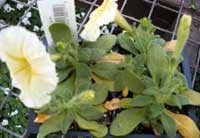How to choose the best annuals
Secrets to picking annuals for bigger and better blooms.
The garden centers are loaded with rainbow colors of annual flowers. Growers know that color will sell flowers so they feed their annuals with higher doses of phosphorus and potassium to get early bloom on immature plants.
Here are a few tips on what to look for to help you become a smart shopper.
Look at the foliage
When picking plants for your flowers beds, don’t be tempted to buy annuals with showy, blooms, pay closer attention to the foliage. You need the foliage to produce flowers. The plant should be healthy and vigorous with thick branching stems, dark green foliage (in most cases) and flower buds just starting to show a bit of color. OAvoid plants that are either too compact or too spindly. Stay away from yellowing or browning leaves and foliage with spots or brown edges that can be a sign of stress, disease or pests.
Check the roots
What’s in the soil is just as important as what is above the soil. I picked out a flat of begonias at a reputable nursery that had great looking foliage but when it was time to plant, I discovered that the roots were over watered, brown and dying. Needless to say, the plants grew poorly and took all season to establish themselves. To check the roots, pop the plant out of its cell pack and inspect the roots; do they fill up the container with a solid white mass or growing out of the bottom of the pot? If so, the plant has been heavily rooted and the roots will need to be trimmed. Is the plant difficult to remove from the container without the soil spilling out with the roots? If so, they are under developed and need more time to grow. The best proportion is an even distribution of cream colored roots and soil.

Don’t be tempted to plant too early.
Tender flowers will sit and do nothing if the soil and air temperature are too cold and if a frost hits, then all will be lost. Soil temperatures should be in the 50’s for safe planting. Warm weather plants such as impatients, tomatoes and peppers should be planted when all danger of frost has passed and night time temperature are above 60F. If you can’t plant right away; water and place the container in the suggested light (sun or shade) during the day when temperatures are warm. Bring indoors/garage at night
Remove flowers
As difficult as this may sound, remove the flowers at planting time, so the plants can focus their energy on more leaf and root production. Also, pinch back any spindly growth to produce bushier plants (except for asters, arctotis and gazania). In the end, you will be rewarded with healthier plants and more flowers all season long.
You might like more info on growing…
cosmos: http://hortchat.com/info/cosmos
impatiens: http://hortchat.com/info/impatiens
geraniums: http://hortchat.com/info/geranium-pelargonium-spp
zinnia care:Â http://hortchat.com/info/grow-zinnia
Hi. I’m very new to gardening and am in desperate need of help. My coleus plants turned reddish brown and look dead overnight. I thought maybe a cat was in my years because not all of them are like this only patches throughout. I’m afraid all my efforts to grown and upkeep my plants is lost. I’ve read where it could be due to too much water as it’s been raining in my area quite a bit. I’m not sure if I should wait to see how they look tomorrow or if by then all will be ruins. My question basically is if too much water is in the soil can the plants recover or is there something I need to do? Please help and thanks.